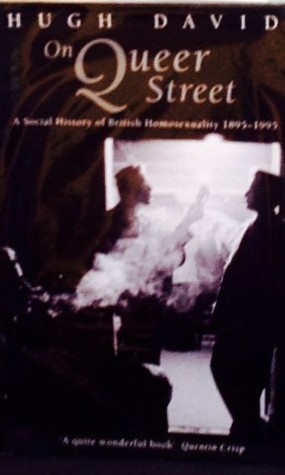Inspiring Older Readers
 posted on 26 Jul 2015
posted on 26 Jul 2015
On Queer Street: A Social History of British Homosexuality, 1895-1995 by Hugh David
You know what it’s like. You go out, you buy a book and you add it to your pile marked ‘to be read’. And then, sometimes, you just don’t get around to it and it finds its way from the reading pile to the pending pile and eventually, unread, back onto the shelves. Periodically you catch it looking accusingly at you when you’re looking for something else and you promise, faithfully, to return to it and finally get around to reading it.
So it went with me and Hugh David’s On Queer Street. Having spent two or maybe even three years slowly vanishing behind the accretion of newer books it unaccountably forced its way into my eye-line and I picked it up and sat down with it. And almost immediately I asked myself the obvious question – why did I wait?
David’s book is a fascinating and accessible history of our social and cultural attitude towards homosexuality from the trial of Oscar Wilde to the emergence of HIV and AIDS. Although it is often amiable in the best traditions of popular history books, the story David has to tell is a tale of social shame. From the perspective of 2014 it’s almost impossible to imagine how a society could be so cruel and demeaning towards men whose only ‘crime’ was to love and desire other men.
There is plenty of detail here about the well known causes celebres like those of Oscar Wilde and Alfred Douglas in the late 19th century that set public attitudes towards homosexuality for the generations that followed. The criminalisation of homosexual behaviour in 1885 under the category of ‘acts of gross indecency’ (a law originally intended to be used to protect very young girls from heterosexual men) remained on British statute books until 1967 when it was repealed for consenting adults over the age of 21.
Inevitably, David’s study focuses on the rich and the middle class because the emotional lives of the poor working class were largely not thought worthy of recording. He is interesting on the way in which up until the 1960s working class men really only appear as objects of sexual fantasy or as something to be purchased. This fetishisation of the working man still plays out today in the gay stereotypes of the soldier, the fireman, the construction worker and the criminal ‘bit of rough’.
Although we are introduced to the cultural glitterati of the inter-war years ( Noel Coward, Beverley Nichols, Auden, Isherwood & Spender) it is really the terrible post-war 1950s and early 1960s that are the real heart of this book and David is able to tell the story of those years with real empathy. As the comparative hedonism and fatalism of the war years gave way to the mean and morally constipated 1950s, the lives of gay men took a decided turn for the worst. The police decided that their role was to enforce the moral certainties and prejudices of the then Home Secretary, David Maxwell Fyfe, who was unstinting in his desire to rid Britain of the corruption of homosexuality. As a result gay men risked blackmail, exposure, arrest and public shame on a scale never before experienced in such a systematic way. Inevitably, the oppression of such a large number of people would eventually lead to a reaction and by the late 1960s social attitudes were beginning to shift.
Even with social attitudes beginning to take on a more liberal hue, police responses to ‘deviant’ homosexual behaviour remained set – an early example of the sort of institutional discrimination that has since become an increasing part of our modern day lexicon. It was this kind of heavy-handed policing in both the USA and Britain that would eventually lead to the Stonewall riots and the emergence of an organised Gay Rights movement. The willingness of Gay men to come together, to see themselves as part of a ‘community’, to begin demanding equality, an end to oppressive behaviour and the right to be seen as having a legitimate cultural identity meant, according to David, that the late 70s and early 80s looked like something of a golden period. But, the emergence of HIV and AIDS quickly put an end to the (almost literal) party and Gay men were once again being targeted as social corrupters – carriers of a ‘plague’ of potentially biblical proportions.
David ends his book with a warning about the growing number of hate-based attacks on people from the Gay community driven by concerns over AIDS and by fear of the unknown. The book shows us, graphically, that for oppressed groups the battle never seems to be won. Gains made in one age and in one sphere of social activity are often lost in another. Constant vigilance is need to make sure that basic human rights are not sacrificed for the sake of brute ignorance and prejudice.
Terry Potter